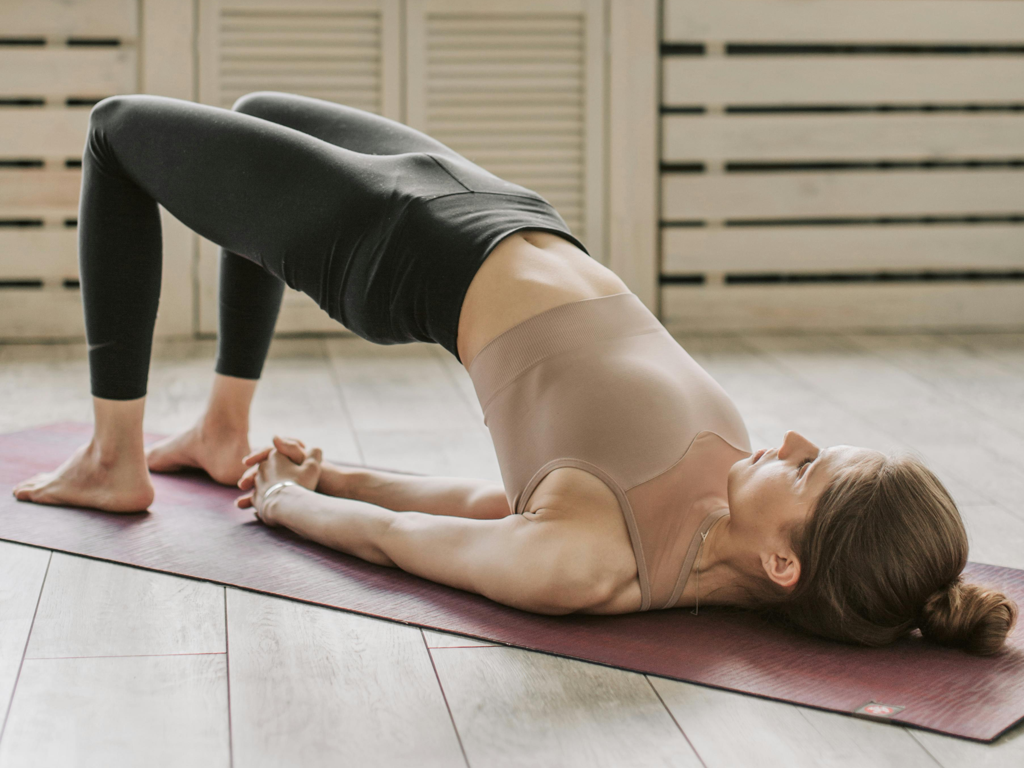On & Beyond the Yoga Mat

Move with Ease: How Yoga Can Help You Manage Back Pain Once and for All
Are you tired of wrestling with nagging back pain that disrupts your daily life? You're not alone. Millions of people suffer from back pain, impacting not just physical health but overall well-being. But there's a powerful solution: yoga. This ancient practice offers not just pain relief but a path towards long-term wellness. Back pain can stem from various factors, including poor posture, a sedentary lifestyle, weak core muscles, and sudden movements. Underlying conditions like arthritis or herniated discs can also play a role. However, psychological stress and emotional tension are significant contributors, tightening muscles and amplifying discomfort. Back pain isn't just a physical inconvenience; it sets off a chain reaction that disrupts our lives. Limited mobility can trigger a decline in physical activity levels, which can then contribute to weight gain and muscle weakness. It can also take a toll mentally, fueling stress, anxiety, and even depression. Disrupted sleep and fatigue often follow, creating a vicious cycle. Yoga offers a unified strategy for managing back pain, working on both the physical body and the mind for lasting relief. Yoga goes beyond stretching and striking poses. By engaging the core muscles, yoga builds a strong internal framework that stabilizes the spine, taking pressure off the back. Core-strengthening exercises like plank and hollow body pose enhance stability and minimize the risk of injury. Yoga also combats stiffness and promotes better posture. By honing in on alignment and posture, you develop the ability to detect tension early on and make modifications to head off discomfort. But yoga's benefits extend far beyond the physical. Deep breathing and relaxation techniques are powerful tools for stress reduction and muscle relaxation. Yoga offers a unified strategy for managing back pain, working on both the physical body and the mind for lasting relief. Yoga also cultivates body awareness. By honing in on alignment and posture, you develop the ability to detect tension early on and make modifications to head off discomfort. This skillset empowers you to manage your back health proactively. If you're looking to deepen your yoga practice and target back pain relief, consider a yoga retreat. Yoga retreats offer an immersive experience in a serene setting, allowing you to focus solely on your practice. With dedicated yoga sessions, workshops, and guided meditations, retreats provide the perfect environment to learn new techniques, refine your practice, and connect with a supportive yoga community. For those who wish to share their yoga journey with others, yoga teacher training is an empowering path. Yoga teacher training programs equip you with the knowledge and skills to guide others on their yoga journeys. Through in-depth exploration of yoga philosophy, anatomy, and alignment principles, you'll gain the knowledge and skills to lead safe and impactful yoga classes, especially those designed to address back pain. Here are some key poses to incorporate into your practice: Listen to your body and prioritize safety: Back pain relief goes beyond yoga. Consider incorporating these lifestyle changes: Yoga is more than just a solution for back pain; it's a path towards holistic well-being. With dedicated practice, it can strengthen your body, quiet your mind, and cultivate a sense of inner peace that permeates every aspect of your life. You might even discover a newfound passion for yoga, a desire to share its benefits with others. Here's where yoga retreats and teacher training come in. Yoga retreats offer an immersive experience, a chance to deepen your practice in a serene and supportive environment. Imagine waking up to stunning scenery, surrounded by a like-minded community, and dedicating each day to yoga sessions, workshops, and meditation. Yoga retreats provide the perfect space to learn new techniques, refine your existing practice, and return home feeling refreshed, rejuvenated, and ready to integrate yoga further into your daily life. For those who wish to take their yoga journey to the next level and share their passion, yoga teacher training is an empowering path. These programs equip you with the knowledge and skills to guide others on their own yoga journeys. By delving deeply into yoga philosophy, anatomy, and alignment principles, you'll develop the skills and knowledge to confidently lead secure and transformative yoga classes, encompassing those specifically tailored to alleviate back pain. So, whether you're seeking relief from back pain or simply interested in exploring the transformative power of yoga, there's a path waiting for you. Unroll your mat, take a deep breath, and embark on a journey towards a healthier, happier you.

Fasting for Clarity and Focus: A Guide to Fasting, Yoga Retreats, and Yoga Teacher Training
In the age of social media aesthetics and fad diets, fasting emerges as a practice shrouded in mystery. But what exactly is fasting, and how does it go beyond trendy green juices and skipping meals? It's a multifaceted practice with a spectrum of experiences and benefits waiting to be discovered. Buckle up as I delve into my recent five-day fasting adventure, unpacking its intricacies and the profound revelations it brought. Fasting transcends the superficial pursuit of weight loss or following the latest intermittent fasting trend. It's a gateway to a deeper exploration of self and a catalyst for renewal. As I embarked on my fasting odyssey, I encountered a kaleidoscope of preconceptions and understandings surrounding this ancient practice. From water fasts to silent meditation retreats, fasting manifests in a multitude of forms, mirroring the rich tapestry of human experience. Each approach offers unique challenges and rewards, catering to individual needs and goals. It's not a rigid, one-size-fits-all solution, but rather a customizable experience designed to work in harmony with your body and intentions. My five-day fasting journey became a profound exploration of physical and mental resilience, peeling back layers of self-awareness with each passing day. Beyond the initial hunger pangs, I discovered a wellspring of clarity and vitality. Here are some key takeaways that transformed my perspective: My fasting journey wasn't a finite experience; it marked the beginning of a lifelong exploration of self-awareness and vitality. As I reintegrated into my daily routine, I carried the lessons learned close to my heart. Each meal became a mindful celebration of nourishment, and each moment an opportunity for growth. Fasting can be a powerful tool for self-discovery, but it's just one piece of the puzzle on your path to well-being. Yoga retreats and yoga teacher training programs offer a transformative space to deepen your practice, explore mindfulness techniques, and connect with a like-minded community. Whether you're seeking a physical challenge, a mental reset, or the skills to guide others on their yoga journeys, consider embarking on a yoga retreat or enrolling in a yoga teacher training program. In a world overflowing with distractions and noise, fasting offers a path to inner stillness and clarity. Whether your goal is physical rejuvenation, mental focus, or spiritual awakening, fasting holds the potential to unlock your fullest potential. So, take a deep breath, quiet the external chatter, and dare to embark on your own transformative fasting odyssey. You might be surprised by the profound revelations that await you within. Unveil your potential with a transformative fasting experience. Explore the power of fasting beyond weight loss and discover the path to inner harmony and vitality. Learn valuable insights from a real 5-day fast and explore the possibilities of yoga retreats and yoga teacher training for a holistic approach to well-being.

A Deep Dive into Restorative Yoga: Your Path to Rejuvenation
Are you a yoga enthusiast seeking a path to deep relaxation and rejuvenation? Consider exploring restorative yoga or embarking on a restorative yoga retreat, a practice designed to be the epitome of peace, calm, and inner peace. This gentle form of yoga offers a magical sense of release, teaching valuable life lessons while guiding you towards complete physical and mental restoration. Whether you're a seasoned yogi or a complete beginner, restorative yoga welcomes you with open arms, fostering self-discovery through supported postures and mindful breathing. Restorative yoga is a deeply meditative practice that prioritizes slowing down and facilitating deep healing within the body. Unlike its more active counterparts, restorative yoga focuses on creating a sense of ease and comfort. Inspired by the teachings of B.K.S. Iyengar, this practice modifies traditional yoga poses to be less challenging and more supportive. A typical restorative yoga session incorporates six to seven poses, each held for extended periods of five to ten minutes. This extended hold allows the body to completely surrender and release tension, ultimately encouraging the nervous system to transition from a state of stress to one of relaxation. Restorative yoga frequently involves gentle twisting movements, seated forward folds, hip stretches, shoulder openers, and supported backbends. By gently targeting the body's connective tissues, these poses effectively release accumulated muscle tension, improve mobility and flexibility, and cultivate a sense of ease throughout the body. It's important to differentiate between discomfort and pain – if you experience sharp pain, adjust the pose with props. However, learning to breathe through slight discomfort is a key element of achieving deep relaxation in restorative yoga. Props are the magic ingredients that truly elevate a restorative yoga practice. They create a supportive haven, enabling the body to fully relax and melt into each pose. Essential props include bolsters, pillows, blankets, yoga blocks, straps, and eye pillows. These props play a crucial role in relieving the muscles from the burden of supporting the body, allowing you to fully reap the benefits of each pose. Don't be discouraged if you lack specific props – get creative! A rolled-up towel or a stack of books can serve as substitutes for bolsters, and blankets can be folded to create makeshift blocks. In today's fast-paced world, restorative yoga offers a much-needed sanctuary for slowing down and prioritizing self-care. This practice allows you to enter a state of "not-doing," a state that is surprisingly powerful in promoting healing. Yoga teacher training can provide you with the knowledge and skills to not only deepen your own practice but also guide others on their journey towards restorative yoga's profound benefits. Here are just a few of the many benefits you can experience through restorative yoga: One of the beauties of restorative yoga is its accessibility. Unlike more vigorous forms of yoga, restorative yoga is perfect for beginners. Each pose can be easily modified with props to accommodate individual comfort levels. If you're new to yoga, simply inform your instructor so they can provide personalized guidance and suggest appropriate props to enhance your practice. While restorative yoga poses may appear similar to yin yoga poses, their intentions differ. Yin yoga poses are designed to target the body's connective tissues and fascia, often involving a degree of discomfort to create a stimulating effect and balance the body's yin and yang energies. In contrast, restorative yoga prioritizes complete relaxation and deep healing, focusing on creating a sense of ease and comfort in each pose. For beginners, restorative yoga might be a more suitable option as it emphasizes comfort and gentle stretching. To fully immerse yourself in the restorative yoga experience and maximize its benefits, take a few moments to create a calming environment before your practice. Gather your props, dim the lights, and consider incorporating aromatherapy with calming essential oils like lavender or sandalwood. This preparation ritual helps you transition from your day-to-day activities and sets the intention for a deeply relaxing and restorative practice. Ready to experience the magic of restorative yoga firsthand? Here's a restorative yoga sequence you can easily practice at home. Gather your props, put on some soothing music, and create a space for complete relaxation. In a world that constantly pushes us to "go, go, go," restorative yoga offers a precious opportunity to slow down, reconnect with ourselves, and prioritize self-care. This gentle practice is accessible to all, regardless of age or experience level. By incorporating restorative yoga into your routine, you'll cultivate a sense of deep relaxation, enhance your flexibility, and experience a profound sense of well-being. So, embrace the stillness, embark on your restorative yoga journey, and allow yourself to truly unwind and rejuvenate. Yoga retreats offer a transformative environment to fully dedicate yourself to restorative yoga. Imagine practicing under clear skies or by the ocean, surrounded by a supportive community. Deepen your practice, unplug from daily distractions, and return home completely rejuvenated.

Achieve Your Wellness Dreams: 7 Steps to SMART Goals in Yoga Retreats and Teacher Training
In the pursuit of wellness, setting goals is not just a practice; it's an art. Achieving those goals, however, requires more than wishful thinking—it demands strategy, dedication, and a touch of humor to keep the journey enjoyable. That's where SMART goals come into play—Specific, Measurable, Achievable, Relevant, and Time-bound. Picture it as your roadmap to success, with a sprinkle of mindfulness and a dash of determination. Here's how to navigate your path to wellness with SMART goals, whether you're embarking on a yoga retreat, diving into yoga teacher training, or simply seeking to enhance your practice. Before diving headfirst into your wellness adventure, take a moment to envision your destination. Set a realistic goal—one that excites you yet is within your reach. Whether it's mastering a challenging pose, deepening your meditation practice, or honing your teaching skills, start with a target that aligns with your current abilities and aspirations. Remember, Rome wasn't built in a day, and neither are wellness transformations. Now that you've crystallized your goal, it's time to give it life. Grab a journal, open a note on your phone, or carve it into stone (if that's your style). Write down your goal with clarity and conviction. Want to lead a yoga class with confidence? Aim to complete a teacher training course within a specific timeframe. Dreaming of mastering inversions? Set milestones to track your progress. Be specific, be bold, and most importantly, be honest with yourself. They say sharing is caring, and when it comes to wellness goals, it's also empowering. Share your aspirations with a trusted friend, your yoga community, or even your furry companion. Vocalizing your intentions not only solidifies your commitment but also invites accountability and support from those around you. Plus, who doesn't love a cheerleading squad during challenging moments? With your goal in sight and your support system in place, it's time to craft your roadmap to success. Design a plan tailored to your lifestyle, preferences, and schedule. If you're aiming to deepen your practice, schedule regular yoga sessions supplemented with meditation and breathwork. For aspiring teachers, outline your study hours, practice teaching sessions, and self-care rituals to maintain balance amidst the journey. As you embark on your wellness journey, remember to honor your body's wisdom and embrace mindful movement. Whether you're flowing through asanas, exploring pranayama techniques, or delving into the philosophy of yoga, listen to your body's cues and adjust accordingly. Progress isn't always linear, but each breath, each stretch, brings you closer to your goal. Wellness extends beyond the mat—it permeates every aspect of your being. Fuel your body with nourishing foods, hydrate mindfully, and prioritize restorative practices to support your journey. Explore holistic approaches to nutrition, incorporating plant-based meals, wholesome snacks, and rejuvenating rituals into your daily routine. Remember, wellness is a lifestyle, not a destination. Along the path to wellness, celebrate every victory, no matter how small. Whether you master a challenging pose, complete your teacher training, or simply show up on the mat consistently, each milestone is a testament to your dedication and resilience. Treat yourself to moments of joy, gratitude, and self-reflection, honoring the progress you've made and the growth that lies ahead. In the tapestry of wellness, setting and achieving goals is a transformative journey—one that requires dedication, resilience, and a sprinkle of magic. With SMART goals as your compass and mindfulness as your guide, embark on your path to wellness with confidence, curiosity, and an open heart. Whether you're stepping onto your mat for a yoga retreat, diving into yoga teacher training, or simply embracing your practice, remember: the journey is yours to savor, every step of the way.

Nama-play! Cultivate Calm & Creativity with Kids Yoga
Yoga isn't just for downward-facing adults anymore! This ancient practice offers a treasure trove of benefits for people of all ages, including our energetic little ones. Introducing yoga to your kids can be a transformative experience, fostering a love for movement, mindfulness, and inner peace. Here are some creative and effective tips to get your child on the yoga mat, sprinkled with "yoga teacher training" and "yoga retreats" to enhance your understanding and open doors to further exploration. Instead of forcing a rigid routine, pique their interest organically. Incorporate yoga into your daily routine, letting your children see you practice. Let them see the joy you find in poses like Mountain (Tadasana), Cat-Cow (Marjaryasana-Bitilasana), and Tree (Vrksasana). Remember, children are natural mimics. Seeing your dedication might just inspire them to playfully copy your movements. Tailor your approach to their age and interests. Younger children often find animal poses utterly delightful. Imagine their faces light up as they roar like lions in Lion Pose (Simhasana) or slither like snakes in Cobra Pose (Bhujangasana). As they grow older, incorporate elements they enjoy, like songs or yoga chants. Chanting simple mantras can introduce them to the power of sound and focus. Remember, kids are boundless balls of energy, not miniature adults. Spark your child's imagination and weave stories around the poses to create an interactive yoga experience. Create imaginative games around your sequences, keeping sessions short and engaging. Let their creativity blossom! If they come up with their own unique variations of poses, celebrate their individuality. This playful approach not only makes yoga enjoyable but also injects a fresh perspective into your own practice. Teaching children to breathe consciously is a cornerstone of yoga. Simple breathing exercises can have profound benefits, equipping them with tools to empower them to find calm amidst everyday pressures.. A great technique to start with is the Bhramari, or bumblebee breath, which has a calming effect on the mind. Have your child sit comfortably, breathe in through their nose, then gently cup their ears with their palms and hum as they exhale. It's a fun and effective exercise they can easily learn and practice throughout the day. For older children, incorporating regular yoga into their lives can be incredibly beneficial. If you find it challenging to maintain consistency, consider enrolling them in a local kids' yoga class. These classes provide a structured and social environment where they can practice with their peers. Family yoga retreats offer a fantastic opportunity to immerse yourselves in yoga together. Imagine practicing under the guidance of experienced teachers in a serene setting. Family retreats can significantly enhance your family's yoga journey, fostering connection and creating lasting memories. Teaching yoga to children requires specific techniques that differ from adult instruction. To ensure a successful yoga practice for your kids, consider exploring resources online that offer valuable tips and materials to make yoga a joyful experience for children.. If you're passionate about integrating yoga into your children's lives, consider enrolling in a kids yoga teacher training course. These comprehensive programs equip you with the skills needed to create a fulfilling yoga practice for your children. Whether you choose a local program or embark on a transformative journey at a yoga retreat, teacher training empowers you to guide your kids on their yoga path. Introducing yoga to your child can be a beautiful journey of discovery. By making yoga accessible and fun, you'll nurture their physical well-being while fostering their mental and emotional growth. Whether through regular practice at home, classes, or family yoga retreats, the benefits of yoga can be a gift that lasts a lifetime. Remember, your passion for yoga can inspire not just your children, but others around you, igniting a lifelong love for this transformative practice. Perhaps, one day, you'll be practicing alongside your child who has blossomed into a confident yogi, thanks to the seeds you sowed today.
Craving More Stories?
Join our ShopYogaRetreats newsletter for the latest updates on thrilling
destinations and inspirational tales, delivered straight to your inbox!
We value your privacy. Your email address will never be shared or published.

Yoga: A Modern Remedy for Healthcare's Biggest Challenges
Modern healthcare faces unprecedented challenges. Explore how yoga retreats and teacher training programs can revolutionize patient care, empower healthcare workers, and create a healthier future. The landscape of healthcare is constantly evolving, and in this transformation, an ancient practice is emerging as a powerful tool: yoga. Yoga's roots may be ancient, but its relevance in addressing modern healthcare challenges is undeniable. From chronic conditions like diabetes and heart disease to the pervasive issue of stress and burnout, yoga offers a holistic approach that complements conventional medicine and empowers both patients and healthcare professionals. Imagine a haven of tranquility dedicated to promoting well-being. This is the essence of a yoga retreat. These immersive experiences provide much more than just an escape from the daily grind. Yoga retreats empower individuals to take an active role in managing their health. Through personalized guidance from experienced instructors, participants delve deeper into yoga practices that extend beyond the physical postures. Yoga retreats can be a transformative space for patients to explore stress-reduction techniques, cultivate mindfulness, and discover a renewed sense of resilience in their health journeys. The impact of yoga extends far beyond the individual. Yoga teacher training programs equip passionate individuals with the knowledge and tools to become catalysts for positive change in the healthcare system. These programs cultivate skilled yoga instructors who can create inclusive and empowering yoga experiences for patients facing a variety of health challenges. Imagine a world where hospitals and clinics offer yoga classes alongside traditional treatments. By empowering patients to manage their stress and cultivate self-care practices, yoga teacher training graduates play a vital role in promoting holistic healing within healthcare systems. The demanding world of healthcare can take a toll on even the most dedicated professionals. Stress, burnout, and compassion fatigue are all too common. Recognizing this critical issue, many healthcare institutions are incorporating yoga programs into staff wellness initiatives. By equipping healthcare workers with stress-management tools and techniques for cultivating resilience, yoga fosters a culture of self-care that permeates clinical settings. Ultimately, this translates into improved well-being for staff, leading to enhanced patient care and a more positive healthcare environment overall. Chronic diseases like diabetes, heart disease, and obesity are major burdens on modern healthcare systems. However, research consistently highlights the therapeutic benefits of yoga in managing these conditions. Yoga practices can help regulate blood sugar levels, improve cardiovascular health, and promote weight management. Beyond managing existing conditions, yoga also plays a crucial role in preventative care. By promoting stress reduction, mindfulness, and healthy movement patterns, yoga empowers individuals to take a proactive approach to their health, potentially reducing the future burden on healthcare systems. Yoga is not merely a trendy fitness routine; it's a powerful force for positive change within modern healthcare. From empowering patients to manage their health to fostering resilience in healthcare professionals, yoga offers a multifaceted approach to promoting well-being. Whether you're a patient seeking a transformative healing experience through a yoga retreat or an aspiring healthcare professional considering yoga teacher training, embracing yoga's potential can usher in a new era of healthcare. This era will be characterized by empowered patients, resilient healthcare workers, and a holistic approach to healing that prioritizes well-being throughout the healthcare journey. Let's embark on this journey together and rewrite the future of healthcare, one mindful breath and movement at a time.

Sheep Out, Yoga In: Unleash the Power of Poses for Dreamland
Are you counting sheep instead of catching Zzz's? You're not alone. Millions struggle with sleep disturbances, leaving them feeling drained and foggy. But what if the answer lies not in counting sheep, but in stepping onto a yoga mat? Here's how embracing a yoga lifestyle can revolutionize your sleep and unlock a world of restful slumber. Imagine drifting off to dreamland, free from the worries of the day. Yoga can make this a reality. By incorporating calming yoga poses (Langhasana poses) into your bedtime routine, you'll lull your body and mind into a state of tranquility. Unlike strenuous workouts, these poses require minimal effort, allowing you to focus on deep body awareness. As you tune into your muscles, you'll release tension and discomfort, creating the perfect foundation for sleep. Pro-Tip: Start with a simple sequence like Legs Up the Wall (Viparita Karani) to promote relaxation, Cat-Cow (Marjariasana-Bitilasana) for gentle back stretches and nervous system calming, and Child's Pose (Balasana) to ease into a peaceful slumber. Devote just 10 minutes to these poses, followed by 10-15 minutes of meditation, and witness the transformation in your sleep quality. Think of forward bends as a warm hug for your entire body. Poses like Hastapadasana gently stretch and soothe your muscles, preparing them for a restful night. Whether you practice them seated, standing, or in Butterfly Pose (Baddha Konasana), remember to prioritize comfort over intensity. The goal is to unwind, not push yourself into uncomfortable contortions. Yoga's ancient practice of Pranayama goes beyond physical postures. It's a powerful tool for managing energy levels and stress. Certain Pranayama techniques can energize you in the morning, while others, like deep, slow breaths through the nose, act as a natural sleep soother. By incorporating calming Pranayama exercises after your relaxing yoga poses, you can normalize your heart rate and prime your body for a peaceful night's sleep. Remember, just like with poses, choose energizing Pranayama for your morning routine to avoid feeling overly awake at bedtime. Meditation is yoga's secret weapon for combating insomnia. By establishing a regular meditation practice before bed, you can enhance your mindfulness and focus. This allows you to gently guide your thoughts away from stress and negativity, fostering a sense of emotional well-being that paves the way for deep sleep. A well-rested body starts with mindful eating habits. While a yoga session might leave you pleasantly hungry, avoid heavy meals before bed. Opt for a light, easily digestible supper. Think calming options like a small portion of cheese or a warm cup of almond milk. Remember to allow at least two hours between your last meal and bedtime to ensure proper digestion. Steer clear of sleep disruptors like alcohol and cigarettes, allowing your body to fully embrace its restorative slumber. Your body thrives on routine, and sleep is no exception. Ensure your sleep and wake times remain steady throughout the week, including Saturdays and Sundays. While life's demands might make a perfectly consistent schedule challenging, prioritize getting 7-8 hours of quality sleep each night. Many yoga apps can be valuable tools to help you establish a regular sleep schedule and track your progress towards restful nights. The tips above are a springboard on your journey to sleep bliss. If you're ready to take a deeper dive into the transformative world of yoga, consider embarking on a yoga retreat. Immersing yourself in a dedicated yoga environment allows you to deepen your practice, learn from experienced instructors, and connect with a supportive yoga community. For the truly passionate, a Yoga Teacher Training program can be a life-changing experience. Not only will you gain the skills and knowledge to guide others on their yoga journeys, but you'll also gain a profound understanding of yoga philosophy and its holistic approach to well-being, including achieving restorative sleep. By incorporating these practices into your life, you'll be well on your way to restful nights and a renewed sense of energy. So, roll out your yoga mat, embrace the power of yoga, and say hello to sweet dreams! Namaste.

Ditch the Couch, Embrace the Downward Dog: Yoga for Flexibility, Strength & Balance
In our whirlwind world of fleeting trends, yoga stands out as a timeless practice that offers a powerful path to physical, mental, and spiritual well-being. Integrating yoga into your routine can significantly enhance your quality of life, making you feel stronger, calmer, and more connected to yourself. Yoga boasts a rich history that stretches back millennia. Countless practitioners have embraced it for its profound impact on both body and mind. The word "yoga" itself translates to "union," symbolizing the harmonious integration of our physical form, thoughts, and spirit. For those devoted to this practice, yoga is more than just exercise; it's a path to self-discovery and inner peace. The beauty of yoga lies in its holistic approach. Unlike other fitness routines, it offers a multitude of benefits that go far beyond physical fitness. Even if you're a complete beginner, yoga can help you reconnect with your body and mind in a meaningful way. With regular yoga sessions, you'll find yourself moving with greater ease and grace as your flexibility and strength improve in tandem. Poses like plank engage multiple muscle groups simultaneously, working your arms, legs, shoulders, and core. Whether you're a seasoned yogi or just starting out, there's always a pose to challenge and improve you. While you might feel a little stiff initially, consistent practice over a few weeks will lead to a noticeable increase in flexibility and overall strength. Improved posture and balance are natural byproducts, reducing aches and pains from poor posture. For those seeking a more vigorous workout, styles like Ashtanga yoga provide a challenging and rewarding experience. Yoga is a potent tool for weight management and overall fitness. A regular yoga practice, even gentle routines, can boost your metabolism, helping you burn excess fat and manage weight in a healthy way. Unlike fad diets, yoga's effects are long-lasting, making it a sustainable choice for long-term health. Poses like boat pose, extended side angle pose, and upward plank pose are particularly effective for weight management. Yoga's benefits extend far beyond the physical. It's a powerful tool for promoting mental well-being and reducing stress. The combination of physical postures, breathing exercises (pranayama), and meditation helps calm the mind, increase mindfulness, and foster a sense of inner peace. Studies have shown that regular yoga practice reduces cortisol (the stress hormone) levels while increasing endorphins, which elevate mood and overall well-being. For those seeking to take their practice to the next level, yoga retreats and teacher training programs offer immersive experiences. Yoga retreats provide an escape from the daily grind, allowing you to fully dedicate yourself to the practice, connect with like-minded individuals, and experience personal growth. These retreats are often held in stunning natural settings, further enhancing the experience. Yoga teacher training equips you with the knowledge and skills to share the gift of yoga with others. Whether you dream of a career change or simply want to deepen your understanding, these programs offer comprehensive training in various yoga styles, anatomy, philosophy, and teaching techniques. By incorporating yoga into your life through retreats or teacher training, you not only elevate your personal practice but also gain the ability to contribute to the well-being of others. Whether your goal is relaxation, personal growth, or a new career path, the world of yoga offers endless possibilities. Ready to embark on a transformative journey towards a healthier, more balanced you? Take the first step today! Sign up for a yoga retreat or enroll in a yoga teacher training program and discover the profound impact yoga can have on your life.

Feel the Earth Beneath You: Why Outdoor Yoga is Essential
Immerse yourself in nature's embrace and elevate your yoga practice. Explore the benefits of outdoor yoga retreats and discover how they can deepen your connection to yourself and the world around you. Perfect for aspiring yoga teachers and yogis seeking a transformative experience. Imagine trading the confines of a studio for a vast, open space. Lush greenery replaces walls, a gentle breeze caresses your skin, and the sun warms your muscles – this is the magic of outdoor yoga. Yoga retreats and yoga teacher training programs are increasingly recognizing the profound benefits of practicing amidst nature's beauty. Unlike crowded studios, outdoor yoga offers unparalleled freedom. Stretch your arms wide without bumping into a neighbor, and flow through poses with complete liberation. This spaciousness is particularly valuable during yoga teacher training, where ample room fosters exploration, experimentation, and a deeper understanding of your practice. Swap stuffy studio air for the invigorating breath of nature. Outdoor yoga allows you to fill your lungs with fresh air, rich in oxygen molecules. These molecules readily enter your bloodstream, boosting your cardiovascular health and energizing your body. Studies have shown that fresh air also contains negative ions, which can help neutralize harmful pollutants and toxins, leaving you feeling refreshed and revitalized. This enhanced oxygen intake isn't just good for your physical health; it can also improve your mental clarity and focus, making your yoga practice even more beneficial. Vitamin D, essential for strong bones and a thriving immune system, is often deficient, particularly in urban areas. Practicing yoga outdoors provides a natural dose of sunshine, promoting the production of Vitamin D. This vital nutrient can help prevent a range of health concerns, including heart disease, depression, and certain cancers. When choosing a yoga retreat, consider a sunny location to maximize your Vitamin D absorption. Studies have shown that direct contact with the earth can improve heart health by reducing blood viscosity. Grounding, achieved by simply walking barefoot on natural surfaces, has also been linked to pain reduction, stress relief, and improved sleep. Incorporate grounding techniques into your yoga teacher training to enhance your practice and experience these profound benefits. The serenity of nature surpasses any indoor environment. Free from the constant hum of traffic and other urban noise, outdoor yoga allows you to sharpen your focus and hone your listening skills. This peaceful setting fosters a deeper connection to your inner self, a core principle emphasized in many yoga retreats and teacher training programs. Practicing yoga outdoors allows you to connect not only with yourself but also with your surroundings. This connection with nature can significantly enhance your emotional well-being. The natural environment helps balance your root chakra, promoting a deeper sense of grounding and security. This harmonization fosters emotional release and self-awareness, crucial for personal growth, both on and off the yoga mat, and a key focus of many yoga teacher training courses. Step off the smooth studio floor and onto nature's ever-shifting canvas. Uneven ground becomes a playground for your balance, prompting you to engage your core muscles even deeper. A gentle breeze dances across your skin, heightening your focus and awareness of your body in space. The sun's warmth bathes you in golden light, loosening tight muscles and promoting a fluidity you might not experience indoors. Many yoga retreats take advantage of this natural studio, incorporating activities like hiking through sun-dappled forests or surfing the rolling waves. Imagine transitioning from Warrior II pose on a sturdy mountain peak to a flowing Vinyasa sequence on a soft, sandy beach – a truly holistic and invigorating experience that pushes your boundaries and deepens your connection to your practice. The benefits of yoga are undeniable, but practicing outdoors takes them to a whole new level. Incorporating outdoor sessions into your yoga routine can revitalize your practice and offer a refreshing change of scenery. The next time you consider a yoga retreat or yoga teacher training program, seek one that embraces the transformative power of nature. Unfurl your yoga mat under the open sky, and embark on a journey of self-discovery and connection with the world around you.

Yoga for Busy Lives: The Gift of Restorative Yoga Retreats & Teacher Training
In our frenetic world, we're constantly bombarded with stimuli that leave us feeling stressed and burnt out. While all yoga styles offer an escape from these pressures, Restorative Yoga stands out for its unique focus on restoring equilibrium to the mind, body, and spirit. This gentle yet potent practice is flourishing in yoga retreats and yoga teacher training programs due to its profound benefits. Intrigued by deepening your yoga practice or exploring a new teaching path? Restorative Yoga might be the ideal fit. Let's delve into what makes Restorative Yoga special, its origins, advantages, and why it's worth integrating into your routine or teaching repertoire. Distinct from today's yoga techniques, Restorative Yoga emphasizes slowing down and opening the body through passive stretches. Props like bolsters, blankets, blocks, weights, eye masks, and straps are used to support the body in various postures, facilitating deep relaxation and release. The core objective of Restorative Yoga's main aim is to achieve complete physical, emotional, and spiritual relaxation. It aims to restore the body's natural balance, alleviate stress, and promote overall well-being. The practice often incorporates minimal lighting, calming music or silence, warmth, and guided breathing to cultivate a tranquil environment. Restorative Yoga has its roots in the teachings of B.K.S. Iyengar, a renowned yoga guru who strived to make yoga accessible to everyone, regardless of limitations. His approach laid the groundwork for this practice, later popularized in the United States by Judith Lasater, one of Iyengar's early students. Lasater introduced Restorative Yoga to a wider audience in the 1970s, emphasizing "active relaxation." Although a relatively new practice, Restorative Yoga keeps evolving as teachers discover innovative ways to support the body and mind through this restorative practice. Restorative Yoga classes are designed to create a profoundly relaxing experience. Here's what you can typically expect: Restorative Yoga offers a multitude of benefits, making it a valuable addition to any yoga practice or teaching curriculum. Here are some key advantages: Restorative Yoga is suitable for everyone, regardless of experience level. However, it's particularly beneficial for: Teaching Restorative Yoga offers unique rewards. As a teacher, you will: Embarking on a restorative yoga journey, whether as a practitioner or a teacher, can be profoundly transformative. Consider incorporating this practice into your next yoga retreat or yoga teacher training program to discover its full potential. Ready to unwind, de-stress, and cultivate inner peace? Restorative Yoga offers a sanctuary from the everyday hustle. Embrace this practice to restore balance, enhance flexibility, and experience deep relaxation. Join a restorative yoga retreat and immerse yourself in a transformational experience. Alternatively, embark on a yoga teacher training program that incorporates restorative yoga to learn how to guide others on this path to well-being. Whether you choose to deepen your practice or share this gift with others, restorative yoga offers a powerful tool for achieving holistic wellness. So, take a deep breath, step onto your mat, and begin your journey to tranquility. In addition to the benefits mentioned above, restorative yoga retreats offer a unique opportunity to: Yoga teacher training programs that incorporate restorative yoga can equip you with the skills and knowledge to: By incorporating restorative yoga into your practice or teaching repertoire, you can unlock a deeper dimension of well-being for yourself and those you guide.
Dreaming of a Yoga Retreat?
We have the best deals and offers from thousands of organizers all over the world! Get them into your mailbox every week!
We value your privacy. Your email address will never be shared or published.

 English
English Deutsch
Deutsch Français
Français Nederlands
Nederlands Español
Español










